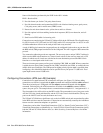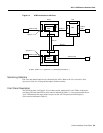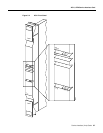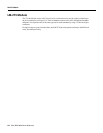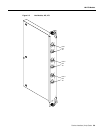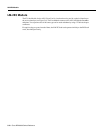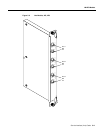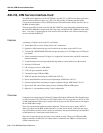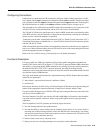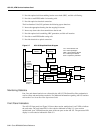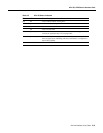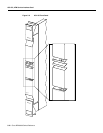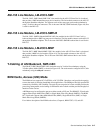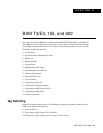
5-12 Cisco BPX 8600 Series Reference
ASI-155, ATM Service Interface Card
ASI-155, ATM Service Interface Card
The ATM Service Interface Card for OC3/STM-1, the ASI-155, is a BPX switch front card used to
interface with an ATM user device e.g., CPE. The ASI provides an industry-standard ATM
User-to-Network Interface (UNI) or ATM Network-to-Network Interface (NNI) over OC3 lines to
the BPX switching fabric.
There are three ASI-155 back cards, the LM-2OC3-SMF for single-mode fiber intermediate range,
the LM-2OC3-SMFLR for single-mode fiber long range, and the LM-2OC3-MMF for multi-mode
fiber. Any of the 12 general purpose slots can be used to hold these cards. These backcards may
also be used with the BNI-155
Features
A summary of features for the ASI-155 card include:
• Virtual Path (VP) as well as Virtual Circuit (VC) connections.
• Support for 1000 connections per port for each of the two ports on the ASI-155 card.
• Two port OC3 SONET/SDH ATM with each port operating at a 155.52 Mbps rate (353,208 cells
per second).
• Allows connections between UNI ports on a single node, between nodes, and NNI connections
between networks.
• Usage Parameter Control using leaky bucket algorithm to control admission to the network.
• Selective Cell Discard.
• 8 K cell ingress (receive) VBR buffer.
• 32 K cell egress (transmit) buffers.
• 2 connection types: CBR and VBR.
• ATM cell structure and format per ATM Forum UNI v3.1.
• End-to-end OAM flows and end-to-end loopback per ATM Forum UNI v3.1.
• External segment flows consisting of segment loopback cells per ATM Forum UNI v3.1.
• Egress from ASI, twelve fixed queues per line, including CBR and VBR queues.
• Optional 1:1 card redundancy using Y-cable configuration.
Overview
Connections are routed using the VPI and VCI address fields in the UNI header. The allowable range
for VPI is from 0 to 255 (UNI) and 0 to 1023 (NNI), while VCI can range from 1 to 65535. A total
of 1000 combinations of these can be used per ASI card at any one time. Future releases will support
the full ATM address range.
There are two connection addressing modes supported. The user may enter a unique VPI/VCI
address in which case the BPX switch functions as a virtual circuit switch. Or the user may enter
only a VPI address in which case all circuits are switched to the same destination port and the BPX
switch functions as a virtual path switch in this case.
There are 12 egress queues per line (port), two of which are used. These are for CBR and VBR.
When a connection is added, the user selects either a constant bit rate (CBR) or variable bit rate
(VBR) connection class.



